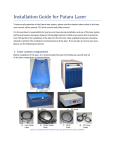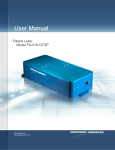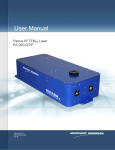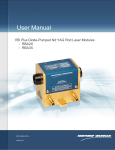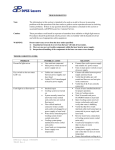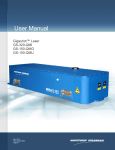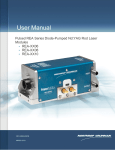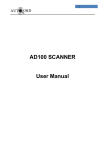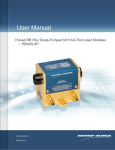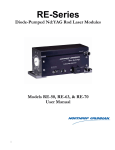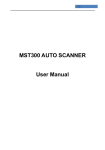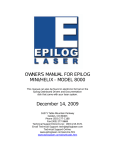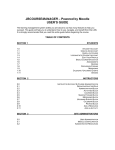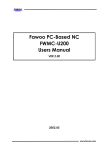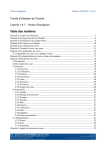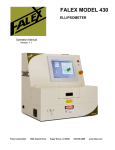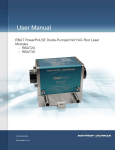Download User Manual - CEO Knowledge Center
Transcript
User Manual Patara Laser -Model PA-016-QTGP Copyright © 2009 Cutting Edge Optronics, a division of Northrop Grumman Corporation. All rights reserved. Northrop Grumman Corporation products are covered by U.S. and foreign patents, issued and pending. Information in this publication supersedes that in all previously published material. Specifications and price change privileges reserved. Northrop Grumman Aerospace Systems Cutting Edge Optronics, Inc. 20 Point West Boulevard Saint Charles, MO, 63301 CEO-UMAN-0031 REV. B August 2010 CEO-UMAN-0031 Rev B Cutting Edge Optronics - NGC 2 PREFACE This manual describes the installation, operation, and service of the Patara Laser System with the eDrive Nitro Diode Driver and Laser Controller. The Patara Laser System emits laser radiation that can permanently damage eyes and skin, ignite fires, and vaporize materials. The Laser Safety section contains information and guidance about these hazards. To minimize the risk of injury or expensive repairs, carefully follow these instructions. Do not attempt to operate the laser system before carefully reading this complete operation manual. If you have any questions on the product which have not been discussed sufficiently within the manual, contact the manufacturer for complete instructions. Failure to heed this warning may result in the destruction or serious damage to the device, and will void the product warranty. The trouble shooting section is intended to help guide you to the source of problems. Do not attempt repairs while the unit is under warranty; instead, report all problems to Northrop Grumman Aerospace Systems Cutting Edge Optronics for warranty repair. We welcome your comments on the content and style of this manual. The last page is a form that can be used to describe issues with the laser. We also suggest that you record information about the laser such as power, settings, time and date. Thank you for your purchase of NG Cutting Edge Optronics instruments. CEO-UMAN-0031 Rev B Cutting Edge Optronics - NGC 3 Table of Contents PREFACE ................................................................................................................................................................ 3 TABLE OF CONTENTS.............................................................................................................................................. 4 LIST OF FIGURES..................................................................................................................................................... 6 LIST OF TABLES ...................................................................................................................................................... 7 SI UNITS ................................................................................................................................................................. 8 ACRONYMS ............................................................................................................................................................ 9 CHAPTER 1, INTRODUCTION ................................................................................................................................ 10 1. 2. THEORY OF OPERATION .......................................................................................................................................10 SYSTEM DESCRIPTION..........................................................................................................................................12 CHAPTER 2, LASER SAFETY ................................................................................................................................... 16 1. 2. PRECAUTIONS FOR SAFE OPERATION OF CLASS IV LASERS ..........................................................................................17 CENTER FOR DEVICES & RADIOLOGICAL HEALTH (CDRH) COMPLIANCE ........................................................................17 CHAPTER 3, SYSTEM DETAILS ............................................................................................................................... 19 1. 2. 3. 4. INTRODUCTION ..................................................................................................................................................19 PATARA LASER ...................................................................................................................................................19 CLOSED LOOP CHILLER ........................................................................................................................................21 EDRIVE NITRO AND TEC DRIVER ........................................................................................................................... 26 CHAPTER 4, INSTALLATION & OPERATIONS ......................................................................................................... 28 1. 2. 3. 4. 5. 6. 7. 8. 9. 10. 11. 12. LASER SYSTEM COMPONENTS ...............................................................................................................................28 UNPACKING ......................................................................................................................................................29 LASER HEAD SETUP.............................................................................................................................................29 EDRIVE SETUP ................................................................................................................................................... 30 CHILLER SETUP...................................................................................................................................................31 CABLES AND WATER HOSE CONNECTION ................................................................................................................32 FIRST-TIME CHILLER TURN-ON PROCEDURE FOR POLYSCIENCE 6000 SERIES ...................................................................37 FIRST TIME LASER TURN-ON PROCEDURES ................................................................................................................39 DAILY OPERATION ..............................................................................................................................................42 CONTROL THE OUTPUT POWER .............................................................................................................................43 EXTERNAL TRIGGERING AND FIRST PULSE SUPPRESSION .............................................................................................43 PATARA LASER WITH EDRIVE NITRO .......................................................................................................................45 CHAPTER 5, MAINTENANCE ................................................................................................................................. 56 1. 2. 3. 4. 5. 6. 7. PREPARATION FOR SHIPMENT ...............................................................................................................................56 HOUSING PURGE................................................................................................................................................56 DESICCANT CARTRIDGE REPLACEMENT ...................................................................................................................57 CHILLER MAINTENANCE .......................................................................................................................................58 CHECKING HOLD OFF ..........................................................................................................................................58 EXTEND LIFETIME OF LASER DIODES .......................................................................................................................58 LASER PERFORMANCE OPTIMIZATION.....................................................................................................................59 CHAPTER 6, CUSTOMER SERVICE ......................................................................................................................... 64 1. 2. BEFORE CONTACT CUSTOMER SERVICE ...................................................................................................................64 MODULE REPLACEMENT ......................................................................................................................................64 CEO-UMAN-0031 Rev B Cutting Edge Optronics - NGC 4 3. 4. 5. 6. 7. RETURN OF THE INSTRUMENT FOR REPAIR ...............................................................................................................64 CONTACTING CUTTING EDGE OPTRONICS................................................................................................................66 WARRANTY .......................................................................................................................................................67 DISPOSAL..........................................................................................................................................................67 ROC ROHS DECLARATION ..................................................................................................................................67 CHAPTER 7, TROUBLESHOOTING ......................................................................................................................... 69 1. 2. 3. 4. LASER TROUBLESHOOTING INTRODUCTION ..............................................................................................................69 PROBLEMS WITH LASER OUTPUT POWER ................................................................................................................69 PROBLEMS RELATED WITH EDRIVE .........................................................................................................................71 EDRIVE OPERATION AND TROUBLESHOOTING .......................................................................................................... 72 APPENDIX, CUSTOMER SERVICE QUESTIONNAIRE FORM ..................................................................................... 73 CEO-UMAN-0031 Rev B Cutting Edge Optronics - NGC 5 List of Figures Figure 1. System Block Diagram .................................................................................................. 13 Figure 2. Radiation Control Drawing .......................................................................................... 18 Figure 3. Warning Labels ............................................................................................................ 18 Figure 4. Patara Front View ......................................................................................................... 19 Figure 5. Patara Rear View .......................................................................................................... 20 Figure 6. Patara Top View ........................................................................................................... 21 Figure 7. Constant Dew Point Lines for Ambient Temperature and Relative Humidity ............ 25 Figure 8. eDrive Nitro Control Panel ........................................................................................... 27 Figure 9. Components for the Patara laser (except the water hoses and filter) ............................ 28 Figure 10. Basic setup for the laser power test ............................................................................. 30 Figure 11. Diagram of water hoses and filter connections ........................................................... 32 Figure 12. Picture of assembled water hoses, filter with the chiller ............................................. 33 Figure 13. Connectors on the back panel of the Patara laser ........................................................ 33 Figure 14. Picture of the back panel of eDrive ............................................................................. 35 Figure 15. Picture of the back panel of TEC Controller ............................................................... 36 Figure 16. First Giant Pulse with the Setting of FPS disabled...................................................... 44 Figure 17. Desiccant Cartridge Top .............................................................................................. 57 Figure 18, Example of dependence of power and pulse-to-pulse instability on the temperature of SHG crystal ................................................................................................................................... 60 Figure 19. Example of dependence of laser performance on the pumping current ...................... 61 Figure 20. Illustration of accessible holes for HR and HM cavity mirror adjustment.................. 62 CEO-UMAN-0031 Rev B Cutting Edge Optronics - NGC 6 List of Tables Table 1 Table of Typical Performance of Patara Laser ............................................................... 13 Table 2 Other Specifications Table.............................................................................................. 14 Table 3 Table of Air Condensation Temperature at Given Ambient Air Temperature (degrees C) and Relative Humidity (percent) ................................................................................................... 26 CEO-UMAN-0031 Rev B Cutting Edge Optronics - NGC 7 SI Units The following System International (SI) units, abbreviations, and prefixes are in NGAS Cutting Edge Optronics, Inc. manuals: Quantity Unit Symbol Abbrv. Prefixes mass gram g tera (1012) T length meter m giga (109) G time second s mega (106) M frequency Hertz Hz kilo (103) k force Newton N deci (10-1) d energy Joule J centi (10-2) c power Watt W milli (10-3) m electric current Ampere A micro (10-6) µ electric charge Coulomb C nano (10-9) n electric potential Volt V pico (10-12) p resistance ohm Ω femto (10-15) f inductance Henry H atto (10-18) a magnetic flux Weber Wb magnetic flux density Tesla T luminous intensity candela cd temperature Kelvin K CEO-UMAN-0031 Rev B Cutting Edge Optronics - NGC 8 Acronyms The following acronyms are in Northrop Grumman Aerospace Systems Cutting Edge Optronics manuals: AO Acusto-Optical (type of Q-switch) BNC Bayonet Neill Concelman Connector CDRH Center for Devices and Radiological Health, U.S. Food and Drug Admin. CEO Cutting Edge Optronics CFR Code of Federal Regulations CW Continuous Wave EO Electro-Optical (type of Q-switch) FET Field Effect Transistor FDA U.S. Food and Drug Administration FPS First Pulse Suppression FWHM Full Width - Half Max GPM Gallons Per Minute HR High Reflector HV High Voltage IR Infrared KTP Potassium Titanyl Phosphate LBO Lithium Triborate Nd:YAG Neodymium-doped Yttrium Aluminum Garnet NGST Northrop Grumman Space Technology NIR Near Infrared OEM Original Equipment Manufacturer PRF Pulse Repetition Frequency PSI Pounds per Square Inch RF Radio Frequency RMS Root Mean Squared SHG Second Harmonic Generator TTL Transistor - Transistor Logic UV Ultraviolet VAC Volts, Alternating Current CEO-UMAN-0031 Rev B Cutting Edge Optronics - NGC 9 CHAPTER 1, Introduction 1. Theory of Operation Patara Laser is a Q-switched intra-cavity, frequency doubled laser oscillator. The output consists of pulses of light at 532 nm wavelength and 60-80 nanosecond pulse duration at repetition frequencies of 4,000 to 10,000 Hz. It is a TEM00 laser and therefore has very high brightness. The CW pumped Nd:YAG rod module in the oscillator is optically excited using arrays of laser diode bars operating at wavelengths in the neighborhood of 806 nm. A laser oscillator consists of an optical amplifier in an optical cavity which serves to form a laser optical mode which can oscillate when the gain of the amplifier is sufficient to overcome the losses in the optical cavity. One such loss is the amount which is allowed to escape the oscillator cavity through one of its mirrors and constitutes its useful output. This basic approach suffices unless the output beam is desired at a wavelength which differs from the fundamental wavelength (1064 nm) of the laser amplifier medium (Nd:YAG). Various nonlinear optic techniques can serve to convert this beam to another wavelength, but usually with some considerable loss of power, or, seen another way, with a considerable residue of unconverted fundamental power. This applies once one has allowed the fundamental radiation to leave the oscillator cavity and the beam is converted outside the cavity. If, instead, the nonlinear conversion is done inside the oscillator cavity the leftover fundamental simply returns to the oscillator and is conserved to be amplified and returned to the nonlinear frequency converter. This way nearly all the power in the fundamental which could have been optimally coupled out of the cavity by a semi-transparent mirror is now converted to another wavelength (provided, of course, that the semi-transparent mirror is replaced by one that is fully reflective at the fundamental wavelength). Patara uses this intracavity technique to double the laser frequency to a wavelength of 532 nm. The frequency doubling device is a crystal of lithium triborate (LBO) cut at a special angle which provides phase matching between the fundamental waves in the beam and the waves generated at 532 nm at around room temperature. Phase matching, and hence, efficient conversion is very sensitive to the angle to the intracavity beam in one direction and also to the temperature of the LBO crystal. It is therefore necessary to provide a very stable mechanical and thermal environment for the doubling crystal. The condition of phase matching can be met either by the angular adjustment of the doubling crystal mechanically or by the temperature of the crystal electrically. Considerations of stability and reliability lead to the doubling crystal being mechanically fixed. The phase matching condition in the Patara laser is realized by the controlling of the temperature of the doubling crystal. The doubling crystal is mounted in a cell on the top of the Thermal Electric Cooler (TEC). The performance parameters are optimized by finding an optimum temperature of the crystal typically between 20º and 50º. Once this temperature is found and fixed, the temperature of the crystal can be kept stable to ±0.1ºC with the TEC controller. The Nd:YAG laser amplifier is also capable of storing a considerable amount of energy due to the long upper state lifetime of the Nd ion. If some kind of device is used to prevent the buildup of optical power in the oscillator cavity by introduction of loss greater than the available gain, energy will accumulate in the gain medium. If this same device suddenly removes this loss, the laser power will increase exponentially with each round trip of the oscillator cavity until much of the stored energy is exhausted and the gain once again falls below the loss. The fact that the time for light to transit the laser cavity is only a few nanoseconds results in this stored energy being released in a very short duration pulse. Such a device is called a Q-switch and they are available in two major types, acousto-optic and electrooptic. The Patara laser uses an acousto-optic Q-switch to form its pulses. The high peak power achieved in this manner is also essential to achieving an adequate fraction of conversion to 532 nm. The conversion process is dependent on the intensity of the circulating 1064 nm power. The laser beam which can circulate inside the oscillator cavity is determined by a process of self-consistency where the beam characteristics at any given location in the cavity are repeated after the beam completes a round trip back to that location. Oscillator beams are composed of transverse modes of simple structure related to a fundamental Gaussian intensity profile mode which is of the smallest lateral extent and divergence in the set. Somewhere in the oscillator path is an aperture which forms the limit to the laser beam‟s transverse spatial extent. It is advantageous for achieving the ultimate power and efficiency from a given laser system for this aperture to coincide with the aperture of the amplifier medium, so that the oscillating beam fills the gain medium to the maximum extent. If the diameter of the fundamental mode is much smaller than the limiting aperture, higher order modes will oscillate and laser beam quality will degrade because these modes have not only larger transverse extent, but also have higher divergence than the fundamental mode. Beam quality is therefore related to the product of the diameter of the beam and its angular divergence as it propagates into the far distance, and this product is conserved with propagation and transformation by optical elements such as lenses and mirrors. Beam quality is also a measure of how small a spot a beam can be reduced by simple focusing, higher quality beams giving focal spots of smaller diameter and higher intensity. This CEO-UMAN-0031 Rev B Cutting Edge Optronics - NGC 11 factor also impacts the amount of harmonic conversion which can be achieved and favors the restriction of laser operation to its fundamental Gaussian mode, such as is used in the Patara laser. The subject of laser cavity design for fundamental mode operation is too involved to pursue here, but it involves the selection of cavity length and the characteristics of the pumped amplifier medium‟s diameter and focal power. It is important to recognize that once the design parameters are selected for optimum fundamental mode operation, they cannot be altered without perturbing the fundamental mode size in the amplifier which may lead to unacceptable changes in performance. This is particularly important to the intensity of amplifier excitation (pump power, or drive current) since this also determines its focal power. Consequently, the amplifier drive current must be kept at all times within a close tolerance of the design point. Suppose, however, that it is necessary to turn the laser output power down from its maximum design value. From the reasoning above, one cannot just turn the power down to the amplifier thereby reducing its gain without unacceptable alterations in the beam characteristics because this is invariably accompanied by a change in its focal power. While it is always possible to attenuate the beam externally to the laser oscillator cavity, this is undesirable since it involves additional optical elements and expense. A corresponding reduction of power, however, is possible if we could turn up the loss of the optical cavity while maintaining the gain at a constant level. The Patara laser achieves power reduction using the latter method. The additional functionality of accepting and executing power level commands is built into the accompanying eDrive electronic system. 2. System Description Patara consists of three interconnected subsystems. The optics subsystem contains the laser oscillator; the eDrive electronic subsystem provides power and control for the laser transmitter, and the chiller which provides thermal control. The user must supply prime power and cooling to the optics subsystem. The interface relationships among these subsystems are shown in Figure 1. CEO-UMAN-0031 Rev B Cutting Edge Optronics - NGC 12 CHILLER, STABLIZED±0.1ºC 52 PSI 1.5 GPM 532 nm, >=16 W @ 4-10 kHz LASER Q-Switch RF Signal Control Signal Diodes Array Power TEC Power SHG Temp. RS232/Trigger ELECTRONICS 4-U eDrive HOST SYSTEM TEC CONTROLLER 110 VAC Figure 1. System Block Diagram Table 1 Table of Typical Performance of Patara Laser Parameter Units Laser Model PA-016-QTG Laser Type DPSS Nd:YAG Wavelength 532 nm Repetition Rate 4 to 10 kHz Output Power @ 9 kHz 16 W Spatial Mode TEM00 Beam Diameter @ 9 kHz 0.9 mm Beam Quality (M2) @ 9 kHz < 1.3 Beam Divergence (FWHM) @ 9 kHz 1.7 mrad Pulse Width (FWHM) @ 9 kHz < 80 ns Pulse-to-Pulse Stability @ 9 kHz < 1.5 % rms Output Stability (Over 8 hours) @ 9 kHz < 3 % rms CEO-UMAN-0031 Rev B Cutting Edge Optronics - NGC 13 Table 2 Other Specifications Table Parameter Performance Electrical Inputs Auto-ranging: 100-250 VAC @ 47-63 Hz Drawing 7A Cooling Closed Loop Recirculating Chiller1 Coolant 460-Purelase 1802,3 Operating Temperature 18-30 °C Laser head size 24" L x 6" H x 8" W eDrive Nitro Size 7" H x 19" W x 17" D 1. Chiller must be able to circulate water at the approximately 60 psi required in CEO lasers, see final test report for each laser specific required pressure. 2. Drain the chiller and flush with cleaning solution (460-CCL2567) every six months. Then put fresh coolant and filter on chiller. 3. Alternately, the laser can be cooled with distilled water as long as a corrosion inhibitor and algaecide are added. CEO recommends Optishield Plus if this option is chosen. Optics Subsystem The optical subsystem consists of an Optical Assembly on a CEO industrial laser optics bench. The Optical Assembly is kinematically mounted to the housing. Electronic Subsystem The electronic subsystem consists of a 4-U sized eDrive and TEC driver. See the eDrive Manual for details. For setup and operation of the eDrive for Patara see chapter 3. Please contact your NGAS CEO service engineer if you need assistance. Operation at reduced power requires that two settings be adjusted in the eDrive, the “Q-switch Power” and the drive current level, “Iset”. A table on the Final Test Report shipped with each laser gives the values which are necessary to achieve the full, 9, 5, and 2 W power conditions. The temperature of SHG crystal for the phase matching is crucial for Patara laser. It determines the performance of the laser. It is set and controlled by a TEC driver. Please read the TEC manual to set and monitor the temperature. CEO-UMAN-0031 Rev B Cutting Edge Optronics - NGC 14 Thermal Control Subsystem Thermal control and heat removal from the Laser Transmitter is accomplished by a chiller provided by CEO or the user. The laser has an integral flow switch which will interrupt drive current to the amplifier module and power to the Qswitch should the flow rate fall below 1 gpm (3.8 lpm). Flow direction is labeled on the laser optics housing below the coupler ports. Please observe the flow direction at all times. The thermal control system must be capable of maintaining the temperature set point to ±0.1ºC with a flow rate of 1.5 gpm (5.7 lpm). This will require a pressure of approximately 49 psi at the input to the laser housing in order to achieve this. Pressures at the chiller may be several psi higher if additional filtering, flow metering, fittings, and long runs of coolant tubing are used. Coolant used in the system must be compatible with the materials used in the internal coolant lines of the laser. Tap water or de-ionized water must be avoided because of corrosion and mineral deposits. CEO supplies an approved coolant for this application. CEO-UMAN-0031 Rev B Cutting Edge Optronics - NGC 15 CHAPTER 2, Laser Safety Please read this section carefully before installing or operating your laser. We recommend that a Cutting Edge Optronics trained Service Engineer performs all service and repair operations. If you do plan to service your laser, please follow the procedures in the Service and Repair section of this Manual. CAUTION The Patara Laser is a Class IV-High Power Laser whose beam is, by definition, a safety hazard. Avoid eye or skin exposure to direct or scattered laser radiation. Avoid direct viewing of the beam or its specular reflection. Follow the instructions contained in this manual for proper installation and safe operation of your laser. We recommend the use of protective eyewear at all times; selection depends on the energy and wavelength of the laser beam as well as operating conditions. Consult ANSI, ACGIH, or OSHA standards for guidance. CAUTION Use of controls, adjustments or performance of procedures other than those specified herein may result in hazardous radiation exposure. WARNING At all times during installation, operation, maintenance, or service of your laser, avoid exposure to laser or collateral radiation exceeding the accessible emission limits listed in “Performance Standards for Laser Products,” United States Code of Federal Regulations, 21 CFR 1040 10(d). CEO-UMAN-0031 Rev B Cutting Edge Optronics - NGC 16 1. Precautions for Safe Operation of Class IV Lasers Never look directly into the laser beam or at specular reflection, even with protective eye wear on. Always wear laser safety eyewear that is optically dense at the wavelengths of operation (798-816 nm pump light, 1064 nm fundamental, 532 nm second harmonic). Set aside a controlled-access area for laser operation; limit access to those trained in the principles of laser safety. Post readily readable warning signs in prominent locations near the laser operation area. Use safety interlocks on all entryways. All CEO system control electronics are provided with interlock inputs to preclude operation with an open safety door. Enclose beam paths wherever possible. Set up experiments so the laser beam is below eye level. Work in an area that is well lighted to avoid dilation of pupils. Set up a target for the beam. Set up shields to prevent reflected beams from escaping the laser operation area. View an infrared laser beam with a protected image converter at an oblique angle reflecting from a diffuse surface. Insure that all electrical connections are made in a safe manner. Where possible, position equipment so that electrical connections are shielded from accidental touch. No smoking, eating, or drinking should be allowed in laser areas. Never leave an operating laser unattended. 2. Center for Devices & Radiological Health (CDRH) Compliance This laser product complies with Title 21 of the United States Code of Federal Regulations, Chapter 1, Subchapter J, Part 1040.10 and 1040.11, as applicable. To maintain compliance with these regulations, once a year or whenever the product has been subject to adverse environmental conditions (e.g. fire, flood, mechanical CEO-UMAN-0031 Rev B Cutting Edge Optronics - NGC 17 shock, spilled solvent), check to see that all features of the product identified on the radiation control drawing (Figure 2) function properly. Also, make sure that all warning labels remain fully attached. Serial Number Class IV Danger Emission Indicator Radiation Emission Non-Interlocked Protective Housing Defeatably Interlocked Protective Housing Figure 2. Radiation Control Drawing Figure 3. Warning Labels CEO-UMAN-0031 Rev B Cutting Edge Optronics - NGC 18 CHAPTER 3, System Details 1. Introduction Operation of the Patara laser head is explained below. Please contact your Cutting Edge Optronics service engineer if you need assistance. 2. Patara Laser The Patara laser head measures 24 in L by 8 in W by 6 in H (not including the connectors at the rear of the laser). The side of the Patara laser has a laser emission indicator. The output window is positioned 76.2 mm (3.0 inches) from the bottom of the Patara laser and 99.7 mm (3.93 inches) from the side with the emission indicator. Emission Indicator Alignment Opening Output Window Figure 4. Patara Front View The rear panel of the Patara laser has connectors for cables. These cables connect to the eDrive Nitro. The back panel also has ports for the coolant in and coolant out. CEO-UMAN-0031 Rev B Cutting Edge Optronics - NGC 19 Nitrogen Purge Valve Alignment Opening Figure 5. Patara Rear View Also located on the front and back panels are alignment openings. The openings are sealed by screws which prevent emission during normal operation. However, the service technician can remove the screws and shine a HeNe laser through the opening to aid alignment. WARNING The screws filling the alignment hole are considered noninterlocked covers. If the screws are not replaced and the Patara laser is run, the opening will function as an aperture. It can allow an output beam of up to 3 W at the same rep rate and pulse-width as the main beam. This beam would be capable of causing eye or skin damage from direct exposure or specular reflection of the beam. Always replace the screws in the alignment holes. Also to aid in aligning the laser, there are adjustment holes in the top cover of the laser housing to allow a technician to access the adjustment screw on the HR cavity mirror and HM cavity mirror. The following images show the position and use of each adjustment screw. The holes to access these adjustments are always open to air; there are no screws to block these holes, as they are not in the direct beam-path. CEO-UMAN-0031 Rev B Cutting Edge Optronics - NGC 20 WARNING The access holes should be always covered unless an alignment is being performed. Any dust invasion through these holes can cause damage to the mirrors and crystals inside the laser. All the holes on the laser enclosure should be sealed all times to prevent moisture penetration. Moisture in the enclosure can degrade the lifetime of SHG crystal as well as the coatings on all optical components. Figure 6. Patara Top View 3. Closed Loop Chiller WARNING Do not operate laser without cooling. Inadequate heat dissipation will seriously damage the laser diodes and will void warranty. The single most common cause of laser return for repair involves customer damage. More than one third of all customer damaged lasers involve cooling problems. Coolant problems almost always require the replacement of the diode arrays - the single most expensive component in CEO lasers. Read the following section carefully to avoid damaging arrays. CEO-UMAN-0031 Rev B Cutting Edge Optronics - NGC 21 Depending on the model of Patara laser, the required heat capacity and flow rate changes. A table listing the requirements for each model is shown below. Model Heat Capacity1 PA-016-QTG 800 W Minimum Flow Rate 1.5 gpm (5.7 lpm) 1. Heat Capacity should be greater than the laser‟s power consumption. Chiller requirements: Capable of recommended flow rate at 60 psi1. Purelase 180 coolant2, Filter3 (connected between chiller and inlet on laser) Chiller Heat Capacity > Laser Power Consumption Flow sensor (Installed internally on Patara lasers) 4 Replace coolant with fresh every six months 1. The actual operating pressure should be somewhat lower than 60 psi. If your chiller can achieve the required minimum flow rate through the laser with a lower water pressure (typically ~55 psi), it is acceptable. 2. Clean coolant is important to keeping coolant lines from clogging. Untreated tap water is not an acceptable coolant and may cause damage. Suitable Coolants include: a. NALCO Purelase 180 b. Distilled water and the combined algaecide and corrosion inhibitor Optishield Plus from Opti Temp, Inc (Traverse City, MI, phone number 231-946-2931 3. The filter should be capable of removing particles 5 µm or larger. The filter should be changed at a minimum of every six months. The filter should be changed more frequently if the chiller manufacturer recommends a shorter interval. 4. When not using CEO drive electronics, verify that flow sensor interrupts current to diodes less than 500 milliseconds after a low flow condition occurs. Avoid with chillers: De-ionized water1 Iron or Aluminum parts in plumbing loop Operation below air condensation temperature2 1. NG CEO has exposed bare copper inside the coolant loop. For this reason, NG CEO does not recommend using untreated DI water. If DI water is used as the coolant, it is very important to maintain the water resistivity between 300 - 700 K ohms and to keep the water slightly basic (i.e. keep the water above 8.0 pH). CEO-UMAN-0031 Rev B Cutting Edge Optronics - NGC 22 2. The Patara laser is environmentally sealed, but not hermetically sealed. Atmospheric conditions near the exterior of the laser will mimic conditions inside laser head. If you notice water in the immediate vicinity of the laser, shut the laser system down immediately. Check to see if the water is coming from the laser head. If so, return the laser for repair. If not, repair the source of the leak and allow the unit to dry thoroughly before resuming operation. The laser system has a coolant loop to prevent thermal damage to the laser diodes. The diodes should be kept at approximately 20-35 oC. See the final test report for optimum temperature and flow rate settings for your laser. Operating the laser diodes for even a short period of time (a few seconds) without coolant will cause permanent damage. To help prevent this, all CEO drive electronics are equipped with a coolant interlock. This interlock interrupts drive current to the diodes when coolant flow rate drops below set point. CEO recommends testing the function of the flow interlock before firing when first setting up the laser system. Turn the eDrive on without current applied to the laser, and then turn the chiller off. A coolant interlock fault should appear on the screen. By testing the interlock with no current to the laser, there is no risk of damaging the laser. WARNING Do not operate coolant system below air condensation temperature (dew point) at laser head. Condensation on the diode arrays can seriously damage the laser head and will void the warranty. Consult a CEO field service engineer if you have any questions. The air condensation temperature (dew point) is the highest temperature a surface can be at and still cause water to form on the surface from the ambient water vapor. The air condensation temperature is dependent on the surrounding air‟s temperature and relative humidity. If a surface (such as a laser diode) is cooled at or below the condensation temperature, water may collect on that surface. A formula for calculating dew point is given below, along with a calculated table. All temperatures are given in Celsius. CEO-UMAN-0031 Rev B Cutting Edge Optronics - NGC 23 Equation 1 Condensation Temperature Td 237.7 (T , RH ) 17.27 (T , RH ) where (T , RH ) 17.27 T RH ln 237.7 T 100 T is the ambient air temperature in degrees Celsius (0 < T < 60) RH is the relative humidity in percent (1 % < RH < 100 %) and Td is the air condensation temperature. For example, if the chiller is running at 22 °C then look at the curve labeled 22 °C (on Figure 3-3, next page). Suppose the ambient air near the laser is at 28 °C (82 °F), look where the gridline for air temperature of 28 °C intersects the curve for diode temperature of 22 °C. At a relative humidity of 70% or greater, condensation will form on the laser diodes. Control the humidity level inside the laser is very important for the lifetime of SHG crystal. The desiccant cartridge on the top cover can help to removes excess moisture from inside the laser head. WARNING Do not operate the laser without a functional desiccant cartridge. Condensation on the diode arrays can seriously damage the laser and may void warranty. CEO-UMAN-0031 Rev B Cutting Edge Optronics - NGC 24 Figure 7. Constant Dew Point Lines for Ambient Temperature and Relative Humidity CEO-UMAN-0031 Rev B Cutting Edge Optronics - NGC 25 Relative Humidity 1% 10% 20% 30% 40% 50% 60% 70% 80% 90% 100% 10 -43.9 -20.2 -11.9 -6.8 -3.0 0.1 2.6 4.8 6.7 8.4 10.0 12 -42.6 -18.7 -10.3 -5.0 -1.2 1.9 4.5 6.7 8.7 10.4 12.0 14 -41.4 -17.1 -8.6 -3.3 0.6 3.7 6.4 8.6 10.6 12.4 14.0 16 -40.2 -15.6 -7.0 -1.6 2.4 5.6 8.2 10.5 12.5 14.4 16.0 18 -39.0 -14.1 -5.3 0.2 4.2 7.4 10.1 12.4 14.5 16.3 18.0 20 -37.8 -12.5 -3.6 1.9 6.0 9.3 12.0 14.4 16.4 18.3 20.0 22 -36.6 -11.0 -2.0 3.6 7.8 11.1 13.9 16.3 18.4 20.3 22.0 24 -35.4 -9.5 -0.4 5.3 9.6 12.9 15.7 18.2 20.3 22.3 24.0 26 -34.2 -8.0 1.3 7.1 11.3 14.8 17.6 20.1 22.3 24.2 26.0 28 -33.0 -6.5 2.9 8.8 13.1 16.6 19.5 22.0 24.2 26.2 28.0 30 -31.8 -4.9 4.6 10.5 14.9 18.4 21.4 23.9 26.2 28.2 30.0 32 -30.6 -3.4 6.2 12.2 16.7 20.3 23.2 25.8 28.1 30.1 32.0 34 -29.5 -1.9 7.8 13.9 18.5 22.1 25.1 27.7 30.0 32.1 34.0 36 -28.3 -0.4 9.5 15.7 20.2 23.9 27.0 29.6 32.0 34.1 36.0 38 -27.1 1.1 11.1 17.4 22.0 25.7 28.9 31.6 33.9 36.1 38.0 40 -26.0 2.6 12.7 19.1 23.8 27.6 30.7 33.5 35.9 38.0 40.0 Table 3 Table of Air Condensation Temperature at Given Ambient Air Temperature (degrees C) and Relative Humidity (percent) If required to operate a laser in conditions near to the condensation temperature, take precautions to keep the laser dry. The laser should be operated inside an area that is purged with gaseous N2 or encased in a sealed enclosure with a desiccant. 4. eDrive Nitro and TEC Driver The eDrive Nitro is a menu driven diode driver and laser controller. The eDrive Nitro regulates the diode drive current, controls the AO Q-switch pulses, and monitors the various interlocks. Also, the front panel has a convenient emergency stop button to halt laser output. CEO-UMAN-0031 Rev B Cutting Edge Optronics - NGC 26 Additional information about the eDrive Nitro can be found in the eDrive user‟s guide. Figure 8. eDrive Nitro Control Panel The TEC driver is use to control the temperature of the SHG crystal. It has a digital display of temperature. The front panel controls may be used to adjust the set temperature, or view actual or alarm temperature. The user friendly, communications software requires no prior programming experience to establish operation. A command set is provided for qualified personnel to program a software interface and data log information. The controller is provided in a plastic case suitable for bench top use. CEO-UMAN-0031 Rev B Cutting Edge Optronics - NGC 27 CHAPTER 4, Installation & Operations To ensure safe operation of the Patara laser system, please read the chapters about safety in the laser user manual, eDrive manual, TEC driver manual and chiller manual. It is the purchaser‟s responsibility for any loss and injury during installation and using of the laser system. Northrop Grumman Aerospace Systems Cutting Edge Optronics (CEO) recommends that the technician from CEO should perform the installation of the laser for the first time or only qualified technicians should be allowed for the installation and maintenance of the laser. If you do plan to service your laser, please follow the following procedures. 1. Laser System Components 1) Laser head 3) eDrive 5) Laser Signal Cable 6) Diodes Power Cable 2) Chiller 4) TEC driver 7) QS RF Cable 8) AC Power Cables Figure 9. Components for the Patara laser (except the water hoses and filter) CEO-UMAN-0031 Rev B Cutting Edge Optronics - NGC 28 Before installation of the laser, familiarize oneself with the components of the laser system. The components for the Patara laser are listed in Figure 9. The water hose and filter will be shown below. 2. Unpacking Your CEO Patara laser was carefully packed for shipment. If its carton appears to have been damaged in transit, have the shipper‟s agent present when you unpack. Inspect the unit as you unpack it, looking for dents, scratches, or other evidence of damage. If you discover any damage, immediately file a claim against the carrier and notify your CEO representative. CEO will arrange for repair without waiting for settlement of your claim. Keep the shipping container. If you file a damage claim, you may need it to demonstrate that the damage occurred as a result of shipping. If you need to return the unit for service, the specially designed carton assures adequate protection. A Patara laser system consists of: 1) Laser head P/N PA-016-QTGP 2) eDrive P/N ED4C-AXA-2440N 3) TEC Controller 4) Laser signal cable 5) Diode power cable 6) Hoses and filter for chiller 7) US power Cord for Chiller 8) US power Cords for eDrive and TEC controller 9) Chiller Please check the contents against the packing list and the sales order. 3. Laser Head Setup The laser head should be mounted on an optical table or equivalent strong flat surface. There are three mounting holes provided to secure the laser. The laser should be installed in a clean environment. In the direction of the laser output beam, a power meter with the power scale up to 30W should be installed approximately 1.5 feet away from the laser. In order to protect the power meter, a negative lens (f=-100mm) with AR coating at 532nm should be installed in front of the power meter as shown in Figure 10. If a negative CEO-UMAN-0031 Rev B Cutting Edge Optronics - NGC 29 lens is not available, the power meter should be at least 2m away from the laser so that the beam size is larger and the power density is below the damage threshold of the power meter. Figure 10. Basic setup for the laser power test 4. eDrive Setup Input Power Use only power cords suitable for your driver. Use a power source that delivers voltage in the range of 90 to 250 VAC-RMS; 47 to 63 Hz. Power switching is done automatically; there are no configuration switches to set for high or low voltage ranging. Observe recommended fuse selection for each voltage range. AC Input Frequency Fuse Ratings (F1, F2) 120V/15A 47-63 Hz 15A 240V/7A 47-63 Hz 8A Mounting There are four holes on the front panel of the eDrive designed for the mounting into an EIA-310D-compliant rack. If the eDrive is to be used on a desktop or table top, it is recommended that the eDrive be equipped with feet to prevent the driver from marring the surface when it is moved. The eDrive must be secured. Clearance Adequate clearance should be allowed on the front, sides, and rear of the eDrive for access to connections and components. The front and rear vents of the CEO-UMAN-0031 Rev B Cutting Edge Optronics - NGC 30 eDrive must be a minimum of 24 inches (61 cm) away from walls or vertical surfaces so air flow is not restricted. 5. Chiller Setup Ambient Temperature and Relative Humidity The Chiller is designed for indoor installation in ambient temperatures between 5° and 30°C (41° and 86°F; relative humidity should not exceed 80% (noncondensing). Location The Chiller should be installed on a strong, level surface and be located as close to possible to the laser. It should not be installed closer than 4 feet (1.4 meters) to a heat generating source, such as heating pipes, boilers, etc. If possible, the Chiller should be located near a suitable drain to prevent flooding in the event of leaks. Do not place it where corrosive fumes, excessive moisture, excessive dust, or high room temperatures are present. For ease of positioning and maneuverability, the Chiller is supplied with casters. The front wheels can be locked to keep the Chiller in place while in use. To help prevent voltage drops, position the Chiller as close as possible to the power distribution panel. Avoid voltage drops by using a properly grounded power outlet wired with 14 gauge or larger diameter wire. The use of an extension cord is not recommended (Note: The Chiller may be located at a level below that of the equipment being cooled. As long as the process remains closed, overflow will not occur when adding cooling fluid to the Chiller reservoir.) Clearance Adequate clearance should be allowed on the front, sides, and rear of the Chiller for access to connections and components. The front and rear vents of the Chiller must be a minimum of 24 inches (61 cm) away from walls or vertical surfaces so air flow is not restricted. Electrical Power An IEC power cord is provided with the Chiller. It should be attached to the receptacle on the rear of the enclosure. Make sure that the power outlet used for the Chiller is properly grounded and matches the voltage and frequency indicated on the identification label on the back of the Chiller. The use of an extension cord is not recommended. However, if one is necessary, it must be properly grounded and capable of handling the total wattage CEO-UMAN-0031 Rev B Cutting Edge Optronics - NGC 31 of the unit. The extension cord must not cause more than a 10% drop in voltage to the Chiller. Chiller Cleaning Procedures ONE HAS TO MAKE SURE THAT THE CHILLER WILL NOT CONTAMINATE THE LASER HEAD. Please follow the proper procedures to clean the chiller before it is connected to the laser head. The procedures are in the CD for the manuals. It is also available through the customer service at NGCEO WARNING DO NOT PLUG THE CHILLER INTO THE ELECTRICAL OUTLET UNTIL THE UNIT IS READY FOR STARTUP. 6. Cables and Water Hose Connection From laser To laser Figure 11. Diagram of water hoses and filter connections Water Hoses and Filter Connections The water hoses and filters are provided by CEO. They should be connected as illustrated in Figure 11. The correct water flow path starts with the supply port of the chiller->filter-> coolant in port of laser head->laser head->coolant out port of laser head->return port of the chiller. Please be aware of the flow direction of the filter. NOTE Hose barbs should have threads wrapped with Teflon tape. CEO-UMAN-0031 Rev B Cutting Edge Optronics - NGC 32 The filter may be attached to the back of the chiller or to the wall. The chiller cover may be required to mount the L-Bracket to the rear of the chiller and holes may have to be drilled. The 1" caps screws protrude through the rear grill from the inside. Water flow direction is labeled on the laser quick disconnects. Figure 12 is the picture of the chiller with water hoses. Please notice that the positions of supply and return ports of the chiller are different from the diagram of Figure 11. Figure 12. Picture of assembled water hoses, filter with the chiller Connections on Laser Head Figure 13. Connectors on the back panel of the Patara laser CEO-UMAN-0031 Rev B Cutting Edge Optronics - NGC 33 Figure 13 shows all of the connectors on the back panel of the Patara laser. All of the connectors are clearly labeled. The steps for the installation follow. 1. Plumbing Connection: Push the barb fittings of water hoses connectors gently into the COOLANT IN and COOLANT OUT ports by following the flow path direction. Wetting the o-rings of the quick disconnect fittings and receptacles can prevent the o-ring from being damaged. Please make sure that the quick disconnect fittings are locked. A clicking sound can be heard once the fitting is locked. 2. Signal Connection: Align the female connector of the laser signal cable to the J1 connector on the laser head. Once it is aligned, the connector can be pushed in. Turn the locking ring of the connector in the clockwise direction until it is locked. 3. Diode Power Connection: Connect the female connector of the diode power cable to the J2 connector on the laser head. Follow the same procedure of step 2. CEO-UMAN-0031 Rev B Cutting Edge Optronics - NGC 34 4. RF Connection: Connect the Q-switch RF cable to the BNC connector no the laser head. The connector should be locked as well by turning it clockwise until it stops. Connections on eDrive and TEC Controller Figure 14 and Figure 15 are the pictures of the back panels of eDrive and TEC controller. Figure 14. Picture of the back panel of eDrive CEO-UMAN-0031 Rev B Cutting Edge Optronics - NGC 35 Figure 15. Picture of the back panel of TEC Controller 5. Signal Connection: Connect the male connector of laser signal cable to the receptacle labeled LASER INTERFACE on the back of eDrive. Follow the same procedure of step 2. 6. TEC Connection: Connect the split branch wire of the laser signal cable to TEC controller. Snap the 3 pin connector into the CONTROL connector on the TEC controller. Use a screw driver to connect TEC power cables (labeled as 1 and 2) as shown below. CEO-UMAN-0031 Rev B Cutting Edge Optronics - NGC 36 7. Diode Power Connection: Connect the diodes power cable to the receptacle ARRAY POWER by following the same procedure of step 2. 8. RF Connection: Connect the QS RF cable to the RF OUT 1 connector as shown below. 9. Connect the power cords for eDrive and TEC driver. 10. Make sure everything is connected properly and locked. Check that all of the interlocks (three BNC: “TRIGGER/GATE IN”, “QWS THERM INTLK”, “INTERLOCK”; one black “CHILLER”; and one white “INTERLOCK” shorting connectors) are in place on the back of the eDrive (see Figure 14). The black and white connectors are not in place during shipment and will need to be connected by the user. 11.Layout all of the cables and water hoses. And mount the water filter securely. 7. First-time chiller turn-on procedure for PolyScience 6000 Series The first-time turn-on procedures should be similar for use with other chillers. The following steps are for chillers of PolyScience 6000 series. CEO-UMAN-0031 Rev B Cutting Edge Optronics - NGC 37 Filling the Reservoir WARNING Do not use untreated De-ionized water in the system as it is aggressive in nature and can attack and corrode the metals within the laser head. Remove the filler cap from the reservoir and, using a funnel, add Purelase 180 until it reaches the MAX line on the reservoir‟s fluid level gauge. When full, remove the funnel, but do not replace the cap at this time. Electrical Power Plug the Chiller‟s power cord into an appropriate electrical outlet. Place the Circuit Breaker/Power Switch on the rear of the instrument enclosure to the “On” position. Three decimal points will appear on the Temperature display; two decimal points will appear on the pressure/flow rate display. Starting Process Fluid Flow Press the Power Button on the front panel. The system startup sequence will begin and proceed as follows: The pump will turn on and fluid will begin circulating through the system. The set point temperature will appear briefly on the Temperature display; after a few seconds, it will be replaced by the actual fluid temperature. Fifteen to 20 seconds after power up, the compressor will begin operating. WARNING Do not allow the chiller to fill the filter housing, as air can become trapped within the system. Make sure no air remains trapped in the lines resulting in a positive back pressure when chiller is turned off. Positive back pressure can hold the flow switch closed even though flow is not being supplied to the laser head. Air is trapped in the lines if the water level drops when chiller is turned on and then rises when turned off. Failure to heed this warning may result in the destruction or serious damage to the device, and will void the product warranty. Check for Leaks Once the pump is turned on, check all of the connectors to see if there is any leakage. Of leakage is observed, turn off the pump immediately and fix the leak. CEO-UMAN-0031 Rev B Cutting Edge Optronics - NGC 38 The reservoir‟s fluid level will drop as the process and/or process cooling lines fill with fluid. Add fluid as follows: Closed Systems: Slowly add fluid to the reservoir until the liquid level remains stable. Open Bath Systems: Adjust the restriction (pinch) valve until the liquid level in both the bath and the reservoir remain stable. Add fluid as needed to bring liquid levels in the bath and reservoir up to the desired level. Make sure the fluid level in the bath is above the opening on the Chiller‟s inlet hose. Replace Reservoir Cap 8. First time laser turn-on procedures Remove the cap that protects laser output window and make sure the window is clean. If not, clean it with a lens tissue and Methanol gently. Turn on and verify the settings of the chiller 1) Turn on the chiller. 2) Check the temperature setting of the chiller. There is a test report attached for each Patara laser. The operational temperature of coolant is written on the report. The temperature setting of the chiller should be the same as in the report. If it is set to a different temperature, change it to match the setting on the report. 3) The minimum flow rate for Patara laser is 1.5GPM. Check the flow rate to make sure it meets the requirement. If it does not, open the valve inside the chiller until it matches the flow rate recorded in the test report. 4) Run the chiller for a period of time and wait for the chiller to stabilize at the set temperature. WARNING Do not operate coolant system below air condensation temperature (dew point) at laser head. Condensation on the diode arrays can seriously damage the laser head. CEO-UMAN-0031 Rev B Cutting Edge Optronics - NGC 39 Turn on and verify the settings of the TEC controller 1. Turn on the power with the switch on the back panel of the TEC controller. 2. By pressing the DISPLAY SELECT button; check if the temperature is set correctly according to the test report. The power, pulse width and stability of the laser are strongly dependent on the actual temperature of the TEC controller. If the TEC temperature does not match the test report, change the temperature setting though increase/decrease button. 3. Wait for several minutes to see if the actual temperature is stabilized at the set temperature. If so, then go to the next step. WARNING Do not set the temperature of SHG below air condensation temperature (dew point) at laser head. Condensation on the SHG crystal can seriously damage the crystal. Turn on and check the settings of the eDrive 1. Flip the power switch on the back panel of the eDrive to the ON or ““ position 2. Make sure that the red EMERGENCY button is released. Turn on the eDrive by turning the key to ON position and pressing the POWER button to power up the eDrive. 3. Check all the laser parameters in the eDrive. Here are the correct settings for the Patara laser Channel: enabled Standby current: 0 A Slew control: Enabled Slew Rate: 5A/sec Current limit: 30A Q switch: enabled QS Frequency: 9 KHz QS window width: 5 µs Q-switch power: 100% CEO-UMAN-0031 Rev B Cutting Edge Optronics - NGC 40 FPS: Enabled FPS mode: standard FPS delay: 250 µs Starting power: see report FPS widow length: see report Modulation type: see report PPK open offset: 0 PPK closed offset: 0 Internal trigger: enabled Shutter FPS:enabled Voltage dropout: 20.0V Current Tolerance: Enabled Set Current Tolerance: 4A 4. Make sure that there are no objects in the laser beam path except for the negative lens and power meter. MAKE SURE PROPER LASER SAFETY EYEWEAR IS WORN TO PROTECT YOUR EYES! 5. Once all the parameters are set correctly, and temperatures of TEC driver and chiller are stabilized, set the current at 10A and press the “EMISSION” button. 6. Press the “SHUTTER” button to open the laser shutter. Gradually increase the current until the laser is firing at very low power. Move the negative lens and power meter so that the beam is going through the center of the lens and hitting the center of the power meter. 7. Gradually increase the current set point to the operating current specified in the test report. Don‟t touch any part of the laser and wait for the laser to stabilize for 1 hour (usually the laser takes around 20 minutes to reach 95% of the maximum power). Then check if the power is close to the result on the test report. 8. Usually the laser needs optimization for the first installation due to the slight differences of environments, chiller settings and vibration of the transportation. If so, please follow the laser performances optimization procedures in the next chapter. CEO-UMAN-0031 Rev B Cutting Edge Optronics - NGC 41 9. Daily Operation Output energy and repetition rate of the Patara System are adjustable over a wide range. However, operating protocols must be observed in order to assure operation without risking internal damage to optical components. Table 1-1 gives a summary of the recommended operation settings for achieving nominal performance levels. CAUTION The output beam of this system is a safety hazard. Avoid viewing the beam directly. Turn On Procedure 1. Turn chiller ON. Verify correct flow rate and temperature setting to value specified on laser test sheet. Wait until chiller has achieved proper temperature, which may take 5-10 minutes. 2. Turn the TEC controller and wait for the temperature stabilized. 3. Turn the eDrive POWER ENABLE key switch to ON. 4. Depress eDrive POWER switch. LCD panel will be illuminated. 5. Press MENU to verify the current and Q-switch settings. 6. Press EMISSION Button to fire the laser diode. 7. Press SHUTTER to begin laser output. 8. Wait for about 20 minutes to attain 95% of nominal output power. Manual Interrupt Procedure 1. Press SHUTTER key on eDrive keyboard. 2. Resume operation by pressing SHUTTER again. Laser will resume operation with no audible warning. (Note: The laser diodes are operated at set pumping current while the shutter is closed.) Shut Down Procedure 1. Press SHUTTER key to stop lasing. CEO-UMAN-0031 Rev B Cutting Edge Optronics - NGC 42 2. Press EMISSION key on eDrive. The pumping laser diode will cease emission. 3. Press POWER key on eDrive and hold for 5 seconds until display turns dark. 4. Turn the eDrive POWER ENABLE key switch to OFF. 5. Let chiller run for 1-2 minutes. 6. Turn off TEC controller. 7. Turn off chiller. Please refer to the separate Operation and Maintenance Manual for the eDrive for detailed operating instructions. 10. Control the Output Power Every laser application needs a particular laser power for the best results. In some cases, the output power has to be changed at different stages even in the same laser process. Typically, the output power of a laser can be varied by changing the pump current. However, the active laser crystals can exhibit strong thermal lensing, which is related to the pump current. Variation of the pumping current results in the change of the thermal lensing. Therefore, the position of the focal point moves as the pump current is varied. This is not desirable for most laser applications especially laser micro-machining. The output power of Patara laser can be changed either by changing the pump current or by changing the Q-switch Power. This unique, patented technology allows users to adjust the laser output power continuously without changing the pump current. The focal point is kept at the same position regardless of the power level. This feature is very useful for precision micro-machining when different power levels are required for the process. Please refer to step 21 in section 12 of this chapter for setting details. 11. External Triggering and First Pulse Suppression The laser may be externally triggered using a TTL signal of 300-500 ns duration. The signal may be input via the BNC connector labeled “External Trigger” on the back of the eDrive controller. CEO-UMAN-0031 Rev B Cutting Edge Optronics - NGC 43 Figure 16. First Giant Pulse with the Setting of FPS disabled WARNING The FPS has to be enabled and parameters for FPS have to be set properly. Failure to suppress the first giant pulse may cause the internal optical damage as well as damage to the work piece. Figure 16 show the RF signal output to the Q-switch without FPS and the laser pulse train with the first giant pulse. If the peak power of these giant pulses is high enough, it can cause the damage on the mirrors as well as crystals in the laser. The giant pulse forms when the lasing was stopped while the pumping light is still on during the laser processing cycle. The amplitude of the giant pulse is dependent on the non-lasing duration as well as the pumping current. For each type of laser processing, a particular pumping current and pulse repetition rate are needed. The giant pulse can be suppressed by enabling FPS and setting the proper FPS parameters. For detailed information, please refer the section of “Configuring the Integrated AO Q-switch RF Driver” on page 37 of eDrive user manual. To set the FPS properly, one needs a photodiode detect with response time 1ns and an oscilloscope. CEO-UMAN-0031 Rev B Cutting Edge Optronics - NGC 44 12. Patara Laser with eDrive Nitro Before operating your Patara laser, follow these setup steps. eDrive Setup 1. Boot up eDrive. A banner detailing the firmware version will briefly appear. 2. Then the display will switch to the main menu. Select the Channel Setup menu. (i.e. Press button marked “X” in picture below.) 3. Select Channel 1. CEO-UMAN-0031 Rev B Cutting Edge Optronics - NGC 45 4. The Channel 1 CW Setup menu will appear. Ensure the leftmost button reads channel enabled. Next, select set current menu. 5. The dial to the right of the screen is used to change the setting. Using this dial set the current. Depress the dial to change to coarse adjustment, if desired. Coarse setting is indicated by 10X on screen. Press done to enter the value. CEO-UMAN-0031 Rev B Cutting Edge Optronics - NGC 46 6. The screen will go back to the Channel 1 CW Setup Menu. Select more options. 7. Select set slew rate which affects the rate at which current increases at initial turn-on of the laser. 8. Again, use the selection knob (dial) to the right of the screen to adjust value. CEO recommends a rate of 5 Amps per second. Press done when finished. CEO-UMAN-0031 Rev B Cutting Edge Optronics - NGC 47 9. Make sure the slew control is enabled. If not, press the button to toggle from disabled to enabled state. 10. Once slew control is enabled, press more to advance to the next menu. 11. Press set current limit. CEO-UMAN-0031 Rev B Cutting Edge Optronics - NGC 48 12. Setting the current limit stops operator from accidentally setting the current above a prescribed limit. CEO recommends a 30.0 Amp current limit. Set value by turning the selection knob. Press done to enter value. 13. To the right of the eDrive Nitro screen, is a row of four labeled buttons and two LEDs. Press the menu button to return to the main menu. 14. Press channel setup. CEO-UMAN-0031 Rev B Cutting Edge Optronics - NGC 49 15. Select Q-Switch. 16. Select set frequency. 17. Dial in the desired repetition frequency. Press done when finished. 18. Select set pulse width to set the duration of the trigger pulse to the Qswitch. CEO-UMAN-0031 Rev B Cutting Edge Optronics - NGC 50 19. Rotate dial to adjust trigger pulse width to 5 microseconds. Press done to enter value. 20. Select more for the other Q-switch options. CEO-UMAN-0031 Rev B Cutting Edge Optronics - NGC 51 21. Select set Q-switch power to reduce laser power from maximum. 22. Set the laser power level control according to the table provided with the laser. Press done to enter value. 23. The display will revert to the CW Q-Switch Setup Menu. Press Set FPS Settings to access the first pulse suppression features. CEO-UMAN-0031 Rev B Cutting Edge Optronics - NGC 52 24. If the FPS function is not enabled, press FPS Disabled to toggle to the enabled state. The display should now read FPS Enabled at the leftmost selection. 25. Laser is ready to fire. If you prefer, you can press menu (see step 11) to return to the main menu. CEO-UMAN-0031 Rev B Cutting Edge Optronics - NGC 53 eDrive Firing 1. Press current command button (right of the display screen) to view status display. 2. Status is displayed. 3. Press shutter command button to open the shutter for firing. Then, press the emission button to start the laser. The lights above both buttons will illuminate and an audible warning signal will indicate the laser is about to start ramping. CEO-UMAN-0031 Rev B Cutting Edge Optronics - NGC 54 eDrive Interrupt Press the shutter button to temporarily stop the laser output. The shutter light will be extinguished. Toggle the shutter open again to resume firing. Note: firing will resume without an audible warning signal. eDrive Shutdown Press the emission button to turn off current to the amplifier module. Light will be extinguished. If the emission button is toggled again, output will resume after a warning signal is given and the laser ramps up to selected current. CEO-UMAN-0031 Rev B Cutting Edge Optronics - NGC 55 CHAPTER 5, Maintenance 1. Preparation for Shipment It is anticipated that in OEM applications the Patara laser will be installed in another system that will be shipped internationally. The Patara optical assembly must be properly prepared for shipment if internal damage is to be avoided due to possible freezing of trapped water in the coolant lines. The procedure is as follows: 1. Ready a dry gas source in preparation for draining the system. Oilfree, dry filtered air or dry nitrogen (N2) gas is recommended. 2. Remove coolant connections from back of laser housing. 3. Connect a dry gas line to the “Coolant Out” connector on housing. Coolant lines must be purged in the proper direction or trapped water may remain in the lines inside the laser. If this trapped water freezes it can cause lines to leak water when operation is resumed. 4. Connect a drain hose with a proper quick disconnect fitting to the “Coolant in” connector on the housing. 5. Purge the lines with for at least ½ hour at 5 psi. 6. Remove purge lines. After the laser is dry it should be placed in a sealed ESD bag with some form of desiccant. Then package the laser securely in a shipping container. The chiller may require similar treatment to remove water or protect it with antifreeze. Refer to the chiller manufacturer‟s instructions. Do not reconnect chiller lines to laser prior to shipment. After shipment, if antifreeze was used, the chiller will need to be drained and cleaned. A new filter and clean Purelase 180 coolant should be added before the chiller is reconnected to the laser. 2. Housing Purge The Patara optics assembly needs to be kept at low humidity in order to protect the SHG crystal, which is slightly hygroscopic, and to prevent the possibility of condensation on the laser diode arrays. The Patara housing provides a level of protection from entry of ambient humidity, but it is not “hermetically” sealed. When operating in a high ambient humidity, precautions need to be taken to keep the interior of the housing dry. The lid of the housing has a port for a desiccant cartridge which should be changed when the indicator on the cartridge is no longer blue. Also, the housing interior can be purged with dry N2 using valves on the rear CEO-UMAN-0031 Rev B Cutting Edge Optronics - NGC 56 of the housing. The valve with the stem is for the inlet line of the purge and the other valve is the outlet. The valves are opened and closed by rotation of the knobs on the valve ends. 3. Desiccant Cartridge Replacement The desiccant cartridge (Figure 17) removes excess moisture from inside the laser head. It is located on the lid of the Patara laser head. The desiccant cartridge must be periodically replaced, so it should be checked at least weekly for exhaustion. Exhaustion is indicated by a change in the color of the indicator paper in the top of the cartridge. While any sector of the indicator paper in the cartridge top remains blue, the cartridge can still absorb water. When all three sectors of the indicator paper turn completely white or light pink, the module has soaked up all the water it can absorb, and therefore must be replaced. The time between replacements varies with the humidity of the region in which you operate your laser and the frequency with which you open the laser head. If the desiccant cartridges go bad in a very short time frame (six weeks) without the laser head having been opened, contact your Cutting Edge Optronics field service engineer. Figure 17. Desiccant Cartridge Top To replace a failed cartridge, simply unscrew the old cartridge, and screw in a new one. Tighten with a quarter turn of a wrench to form a good seal. The desiccant cartridge used in the Patara laser head is an industry standard part - part number 680300. Replacement cartridges may be purchased from Humidial Corporation (909) 825-0923 Or Delta Adsorbents (630) 595-3286. CEO-UMAN-0031 Rev B Cutting Edge Optronics - NGC 57 WARNING Do not operate the laser without a functional desiccant cartridge. Condensation on the diode arrays can seriously damage the laser and may void warranty. 4. Chiller Maintenance The 5 micron filter on the water chiller should be replaced every six months at minimum. If the water chiller manual suggests more frequent changes, comply with that recommendation. Drain and re-fill the chiller per the chiller and coolant manufacturer‟s instructions. 5. Checking Hold Off Checking hold off is a technique needed to verify proper operation of the laser. To check hold off, perform the following: 1. Turn on the laser and run for at least 20 minutes. 2. Lower the pump current to 10A. 3. Set the QSW internal trigger (or external gate) mode to external trigger mode in the channel menu on the eDrive. Ensure there is no input to the external gate BNC on the back panel of the eDrive. See page 102 in the eDrive manual for details. 4. Gradually increase the pumping current to the operation current. 5. Observe the beam output on the power meter. Hold off condition is met when no green light is visible. 6. If green is observed, the laser does not hold off and may need internal repair. 7. Reduce the current to 10A. 8. Return the eDrive to internal trigger (or external gate) mode. 9. Gradually increase the current to the operation current. 6. Extend Lifetime of Laser Diodes The specification for laser system optical output is provided in the final test report delivered with the system. During its early lifetime, the laser diodes will deliver this specified power at or below the preset current limit. As the diodes age, current increases may be required to maintain power and beam quality so the CEO-UMAN-0031 Rev B Cutting Edge Optronics - NGC 58 diodes can be used for much long time. Once the maximum current of 30A is reached, one should consider replacing new diodes or upgrading the laser. Please contact CEO for detailed information. 7. Laser Performance Optimization When the laser is initially installed or the laser performance has degraded due to the aging of laser diodes possibly, it is necessary to optimize the laser performance. For this procedure, one should see the green light from the laser. In the absence of any visible output, please look into the trouble shooting or contact CEO for help. To reach the best performance, the laser may just need very little adjustment for the optimization. Here are the procedures one should follow: 1. Wait for the laser reach thermal stabilization Both the laser bench temperature and environmental temperature significantly impact the laser power. Wait for the laser to be thermally stabilized before attempting any adjustment. 2. Check the settings of the eDrive and chiller During installation, it is advised that the performance of the laser be checked according to the factory‟s default settings. Check that all of the eDrive settings are correct. The water flow rate and coolant temperature have a significant impact on the laser performance. Make sure that the flow rate is above 1.5GPM and the temperature of the chiller is right according to the test report. 3. Peak up the laser power by tuning the temperature of the TEC controller The phase matching of the second harmonic generation (SHG) crystal is crucial for the Patara laser. It is realized by setting the proper temperature on the SHG crystal. The temperature is controlled by the TEC controller. Figure 18 shows an example of the dependences of the power and pulse-to-pulse instability on the temperature of SHG crystal. As shown in the example, one should choose the middle point of the temperature band, which is around 28.5 oC according the above figure. The laser may have the best power at 29.3 oC in this example, CEO-UMAN-0031 Rev B Cutting Edge Optronics - NGC 59 but a small temperature change on the SHG could result in power fluctuation. Figure 18, Example of dependence of power and pulse-to-pulse instability on the temperature of SHG crystal 4. Peak the laser power by tuning the current Figure 19 shows an example of the dependence of the output power and pulse-to-pulse instability of Patara laser. As one can see, the laser power increases as the pumping current is increased. The laser had the peak power around 23A in this case. One should search for the peak power by changing the current in steps of 0.1A around the operating current. Once the peak power is found, one should lower the current to have 99.5% of the peak power. Set it as the operating current. In this example, the operating current would be 22.9A according to figure 19. The slight difference between the actual operating current and the one on the test report may be due to the performance difference of the chillers. An increase of in the pumping current can compensate for the aging of the laser diodes inside the Patara laser. CEO-UMAN-0031 Rev B Cutting Edge Optronics - NGC 60 Figure 19. Example of dependence of laser performance on the pumping current 5. Peak up the laser with adjustment of the cavity mirrors WARNING MAKING MIRROR ADJUSTMENTS CAN BE NON-REVERSIBLE. IT CAN BE DIFFICULT TO RETURN THE LASER TO THE INITIAL STATE. DO THIS STEP ONLY WHEN ALL ABOVE STEPS ARE FINISHED AND LASER DOESN‟T MEET THE SPECIFICATIONS WITH THE CORRECT SETTINGS. a. Identify the locations of access holes for HR and HM mirrors. Please pay attention to the positions of HR and HM mirrors with respect to the direction of the laser output. b. Remove screws from access holes only in a dust free environment. c. Use a 1/8” ball driver to make adjustments. A final adjustment is 1° or less rotation. A small adjustment is about 2° of rotation. A coarse adjustment is 15 or 20° of rotation. If coarse adjustments are needed to obtain performance, reduce operating current by 2A. Return to normal operating current when making small and final adjustments. CEO-UMAN-0031 Rev B Cutting Edge Optronics - NGC 61 Figure 20. Illustration of accessible holes for HR and HM cavity mirror adjustment d. The screws for the adjustments of the vertical tilt angle and the horizontal tilt angle are illustrated in Figure 20 above. e. Adjustment procedures for the power optimization • Make small adjustments to the horizontal angle of HM mirror and observe the output power. • Once a maximum is found, try adjusting the vertical control of HM mirror to maximize power. • Make small adjustments to the horizontal angle of HR mirror and observe the output power. • Once a maximum is found, try adjusting the vertical control of HR mirror to maximize power. • Go back to steps 9.3 and repeat the optimization steps until there are no significant performance improvement. • If the laser power can‟t be restored to the specification, or the laser is not stable, then the procedure of “Walking the Cavity” can be tried: o „Walking the cavity‟ is sometimes required to optimize the laser and involves combining mirror mount and SHG crystal temperature adjustments. o Reduce current by 1A while making coarse adjustments. Return current to normal when making fine adjustments. CEO-UMAN-0031 Rev B Cutting Edge Optronics - NGC 62 o Make a horizontal adjustment to the HM mount. Recover the laser power by making a similar adjustment to the horizontal control of the HR mount. Check and adjust the temperature of SHG crystal. o Continue if improvement is noted. If no improvement try the opposite directions. o Perform the same procedure adjustments of the HM and HR mount. with the vertical o Typically, SHG temperature adjustment is not needed when doing vertical adjustments. Periodically check for hold off when making these adjustments (see the steps in chapter 5 of the user manual to check for hold-off). • If the laser reaches within +/-5% of nominal power (typical power meter accuracy), and it has good beam shape and stability, one should stop and replace the access screws in the cover. CEO-UMAN-0031 Rev B Cutting Edge Optronics - NGC 63 CHAPTER 6, Customer Service At Northrop Grumman Cutting Edge Optronics, we are proud of the durability of our products. Our manufacturing and quality control processes emphasize consistency, ruggedness, and high performance; nevertheless, even the finest instruments break down occasionally. We believe that the reliability record of our instruments compares favorably with that of our competition, and we hope to demonstrate that we provide superior service by providing dependable instruments and, if the need arises, service facilities that can restore your instrument to peak performance without delay. When calling for service inside the United States, dial (636) 916 - 4900. To phone for service in other countries, contact your sales agent. 1. Before Contact Customer Service Before you pick up phone or send email out to ask help from NG Cutting Edge Optronics, please fill out the questionnaire attached in the appendix of this manual. It may take you a few minutes, but it will help us to help you effectively. In some cases it may prevent an unneeded return if a quick fix can be done onsite. Please make of copy of the form. Fill it with information as detailed as possible. Either scan and email or fax it to us and bring it to the attention of our service department. 2. Module Replacement Even though the pump module is user replaceable, we suggest that the laser head be returned to CEO for the upgrade or contact CEO for detailed instructions about module replacement. 3. Return of the Instrument for Repair DON’T SHIP ANY INSTRUMENTS TO NG CEO BEFORE YOU GET RETURN MERCHANDISE AUTHORIZATION (RMA). Contact CEO or your local distributor for RMA and shipping instructions, and forward the instrument prepaid to the destination indicated. CEO-UMAN-0031 Rev B Cutting Edge Optronics - NGC 64 CAUTION Failure to obtain proper shipping instructions may result in damage to the instrument. Special Cutting Edge Optronics packing boxes designed to securely hold instruments during shipment should be used. If shipping boxes have been lost or destroyed, we recommend that you obtain a new one, for a nominal charge, from NG Cutting Edge Optronics. Remove all water from laser prior to packaging for shipment. See Chapter 5 for details. Place laser in a sealed ESD bag inside shipping container. Place some form of desiccant in bag. WARNING Residual water damage, due to condensation or expansion when tightly sealed, can be catastrophic to the diode arrays or laser rod if not dealt with properly, such damage is excluded from warranty coverage. CEO-UMAN-0031 Rev B Cutting Edge Optronics - NGC 65 4. Contacting Cutting Edge Optronics Phone 1-636-916-4900 Fax 1-636-916-4994 Address Cutting Edge Optronics 20 Point West Blvd. St. Charles, MO 63301 USA Web site www.northropgrumman.com Search: ceolaser Email [email protected] Sales support 1-636-916-4900 Service support 1-636-916-4900 Technical support 1-636-916-4900 8:00 a.m. to 5:00 p.m. Central time After office hours, please leave a voice mail message. Outside North America, contact a Cutting Edge Optronics sales office or distributor; see the Cutting Edge Optronics web site for a list of offices. CEO-UMAN-0031 Rev B Cutting Edge Optronics - NGC 66 5. Warranty CEO sends the applicable warranty to the prospective purchaser with each quote. Contact CEO Sales and Marketing personnel for additional copies or to answer any warranty questions. 6. Disposal In accordance with WEEE (Directive 2002/96/EC of the European Parliament and of the Council of 27 January 2003 on waste electrical and electronic equipment), Cutting Edge Optronics accepts the return of our products for disposal. Please package the products as directed for a return for repair. Contact NGST CEO or your local distributor for shipping instructions and indicate inform them of a return for disposal. Forward the instrument prepaid to the destination indicated. 7. ROC ROHS Declaration In accordance with the Clause 6.2 of Marking for Control of Pollution Caused by Electronic Information Products (SJ/T11364:2006) for Measures for the Administration on Pollution Control of Electronic Information Products No. 39, Order of the Ministry of Information Industry of the Peoples Republic of China, NGST CEO includes the following information about our laser modules. See next page CEO-UMAN-0031 Rev B Cutting Edge Optronics - NGC 67 The translation document above is according to clause 6.2 of SJ/T 11364:2006 CEO-UMAN-0031 Rev B Cutting Edge Optronics - NGC 68 CHAPTER 7, Troubleshooting 1. Laser Troubleshooting Introduction The troubleshooting section is intended to help guide you to the solutions of problems encountered during normal use. WARNING Do not attempt repairs while the unit is under warranty; instead, fill out the form in the appendix in this manual and report all problems to Northrop Grumman Aerospace Systems Cutting Edge Optronics for warranty repair. Before starting any adjustments or troubleshooting procedures, go through this checklist: • Is the eDrive operating at the correct output current? Verify the current set point is that called for in the ATP. • Verify that the eDrive QSW power control is at 100%. • Make sure that the Q-switch is enabled • Is the Q-switched triggered at 9 kHz and triggered by internally • Verify the chiller set point temperature and flow rate are correct. • Both the laser and chiller should be in operation for at least 20 minutes to reach full power and stability before any adjustments are made. If these conditions are met, then consider adjustments. Do not adjust the laser system unless these conditions are verified. 2. Problems with Laser Output Power Low Output Power (0.01-16W) Possible cause: low Q-switch power Check the setting of the Q-switch power in the eDrive. If it is not set to 100%, change it. CEO-UMAN-0031 Rev B Cutting Edge Optronics - NGC 69 Possible cause: power meter problem Check with another good power meter and make sure the measurement is operating correctly. Possible cause: pumping current was low Check the setting current and actual current, too high current or low current result in low power. Possible cause: the temperature of the water is not set properly Check with the chiller. Make sure the chiller has right water flow rate and temperature to the laser head. Possible cause: the phase matching condition of SHG crystal is not met Check the temperatures of TEC driver and make sure it works properly. Possible cause: the laser is running in CW mode or problem with hold off Check the hold-off of the laser and make sure the Q-switch is enabled and RF driver in eDrive function properly. Possible cause: the pulse repetition rate was not correct pulses. Check with the PRF in eDrive or the frequency of trigger Possible cause: the laser was misaligned Perform the laser power optimization procedures as described in the manual to bring the power back. Possible cause: the laser had internal optical damage or the rod was contaminated by water or the diode reached the end of lifetime if the laser power can‟t be restored after optimization. Contact CEO or other qualified technician for service. No Output Power Make sure that the pumping current is set at operation point. Make sure that the Q-switch is not held-off. The laser is triggered at preset PRF with internally or externally triggering source. CEO-UMAN-0031 Rev B Cutting Edge Optronics - NGC 70 Verify the shutter light is lit on the front of the eDrive indicating that shutter is open on the laser. Verify there are no interlock warning messages on the eDrive and that the eDrive is supplying the correct current. Verify the eDrive is not gated off externally and not commanded to low or 0% QSW power. Laser Flicker When the external perturbations are applied to the laser system, the laser exhibits the flickering. Make sure the laser performance is optimized. Make sure there is no strong vibration forces applied to the laser head. Make sure that the flow rate to the laser head is above 1.5GPM and the water flow is not intermittent. Make sure the laser has good output power. A laser with high modulation loss or low pumping current is sensitive to the perturbation. Make sure the pumping current is stable. Make sure the Q-switch hold-off is good. 3. Problems Related with eDrive CW Power Only, No Optical Pulsing Perform initial check on system. This is typically caused by wrong settings or an eDrive problem. Check setting procedures or see eDrive troubleshooting section for procedures and details. Hold Off Failure Perform initial check on system. This is can be Q-switch low power fault of an eDrive problem. See eDrive troubleshooting section for procedures and details. repair. It can also be caused by a failing QSW. This is an internal laser In some cases, a re-tuned laser can suffer from hold off loss. The fix is to change the angle of the QSW. Since QSW angle cannot be adjusted outside the laser, internal service will be required. CEO-UMAN-0031 Rev B Cutting Edge Optronics - NGC 71 4. eDrive Operation and Troubleshooting The eDrive has built-in diagnostics to alert the user of fault conditions. Following are the more common error reports and suggested remedies. Consult the eDrive manual for more details. Laser Water Fault Detected Check chiller for operation and/or low water level. Hardware Fault Detected Check that the Emergency Stop Button is not depressed. Check INTERLOCK input on back panel for open condition. Cover Interlock Fault Detected Make sure the cover is secure on the laser. Check cable connections to laser. Q-Switch Driver Over-Temp Fault Verify the cooling fan for the RF driver is operational. Verify that the airflow through the driver is not obstructed. This fault won‟t clear until the RF driver has had time to cool down. Q-Switch HVSWR Fault Check RF cable connection to laser. Perform RF output power check. The Q-switch has failed if the measured RF power is around 20W with 50Ω RF dummy load. Need repair service. Q-Switch Low Power Fault Perform RF output power check. Verify voltage to RF driver. Adjust RF power if needed. Channel Over Temperature Fault Check eDrive fan for operation. Verify that the airflow through the driver is not obstructed. CEO-UMAN-0031 Rev B Cutting Edge Optronics - NGC 72 Appendix, Customer Service Questionnaire Form We have provided this form to encourage you to tell us about any difficulties you may have experienced in using your Northrop Grumman Cutting Edge Optronics instruments or its instruction manual. Problems that did not require a formal call or letter to our service department, but that you feel should be remedied. We are always interested in improving our products and manuals, and we appreciate all suggestions. Thank you. Date: Name: Company or Institution: Department: Address: Laser Model Number: Serial Number: Chiller Model Number: Serial Number: eDrive Model Number: Serial Number: Laser Manufacture Date: Total laser lifetime: CEO-UMAN-0031 Rev B Cutting Edge Optronics - NGC hours 73 Questions What is the water flow rate (GPM)? _______________________________________________________ What is the set temperature on the chiller (oC)? _______________________________________________________ What is the water pressure on chiller (PSI)? _______________________________________________________ What are the temperature set and actual reading from TEC driver (oC)? _______________________________________________________ What are the set current and actual current from eDrive (A)? _______________________________________________________ Is Q-switch enabled (yes/no)? _______________________________________________________ Is Q-switch triggered internally or externally? _______________________________________________________ What is the Q-switch power (%)? _______________________________________________________ Is FPS enabled (yes/no)? _______________________________________________________ What are the FPS parameters? _______________________________________________________ What is the pulse repetition frequency (kHz)? _______________________________________________________ Is the output power measured directly from the laser (yes/no)? _______________________________________________________ What is the measured power (W)? _______________________________________________________ When did the problem happen? _______________________________________________________ CEO-UMAN-0031 Rev B Cutting Edge Optronics - NGC 74 Have you changed any settings recently (yes/no)? _______________________________________________________ Have you adjusted the laser to try to fix the problem (yes/no)? _______________________________________________________ What are the changes made recently to the system? _______________________________________________________ _______________________________________________________ _______________________________________________________ Please describe the problem or laser behavior as detailed as possible: _______________________________________________________ _______________________________________________________ _______________________________________________________ _______________________________________________________ _______________________________________________________ _______________________________________________________ _______________________________________________________ _______________________________________________________ _______________________________________________________ _______________________________________________________ _______________________________________________________ _______________________________________________________ _______________________________________________________ _______________________________________________________ _______________________________________________________ _______________________________________________________ _______________________________________________________ _______________________________________________________ _______________________________________________________ _______________________________________________________ CEO-UMAN-0031 Rev B Cutting Edge Optronics - NGC 75 _______________________________________________________ _______________________________________________________ _______________________________________________________ _______________________________________________________ Suggestions _______________________________________________________ _______________________________________________________ _______________________________________________________ _______________________________________________________ _______________________________________________________ _______________________________________________________ _______________________________________________________ _______________________________________________________ _______________________________________________________ Email or fax to: Northrop Grumman Space Technology Cutting Edge Optronics, Inc. 20 Point West Boulevard Saint Charles, Missouri, 63301 USA (636) 916-4900 tel. • (636) 916-4994 fax Email: [email protected] CEO-UMAN-0031 Rev B Cutting Edge Optronics - NGC 76












































































